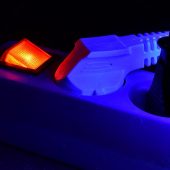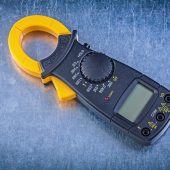LCR meters are often used in high-precision work — measuring, testing and calibrating electronic components. So it’s important that the LCR meter itself provides highly accurate readings.
Regularly calibrating an LCR meter ensures it maintains high precision. How exactly you go about calibrating it depends on the type and model of the LCR meter.
Importance of Calibrating an LCR Meter
An LCR is no different from other tools and equipment used for testing in that it loses accuracy over time.
This can be because of various factors such as how it is maintained, exposure to extreme temperatures, exposure to parameters beyond the recommended ones such as too much current or voltage and so on.
As the precision of an LCR meter drifts, it results in increasingly inaccurate measurements. Considering how important an LCR meter is in the manufacture and testing of electrical components, inaccurate readings can have serious effects.
Calibrating an LCR meter also ensures there’s no unwanted influence on the measurements, especially from the test leads. This type of calibration is called zeroing and it is extremely important in the precision and accuracy of an LCR meter.
Can I Calibrate an LCR Meter Myself?
It depends on the kind of LCR meter you have. Most LCR meters have a ‘CAL’ button, which stands for calibration. If you have that button on your meter, then you can calibrate it yourself.
But this is not a full calibration. The only thing it does is to zero out the meter to ensure there’s no interference from any impedance in the test leads.
A full calibration involves testing an LCR meter for accuracy and, if necessary, adjusting it to the proper readings. This is a more complicated process that’s typically not possible for most users to do on their own. It requires technical skill and specialised equipment.
Even if you can calibrate an LCR meter yourself, you may need to have a third party service do it to ensure traceable calibration. A certificate of calibration is essential when using equipment in commercial/industrial applications.
Three Ways to Calibrate an LCR Meter
Open/Short Calibration
Open/short calibration is the most common type of LCR meter calibration. It’s also called zeroing.
Zero calibration measures the impedance (resistance to AC current flow) and takes it into account when measuring the resistance, inductance or capacitance of a component. This ensures accurate results.
It’s important to perform a zero calibration whenever you test a different electrical component or change the test leads. At the very least, do a zero calibration once a day.
To perform an open/short calibration, look for the CAL button on your meter. If it’s not present, check the menu to see if there’s a calibration setting. If you still can’t find it, that probably means you cannot calibrate the meter. Check with the user manual or manufacturer to confirm.
If you have the calibration option, here’s how to zero an LCR meter.
Tip: Your LCR meter may have a slightly different process. Check the user manual for precise calibration instructions.
- If you are in the middle of a test, disconnect the test leads from the load.
- Press the calibration option to bring up the calibration menu. Some LCR meters require a long press to go into calibration mode.
- In the ‘Open’ calibration mode, leave the leads as they are (attached to the meter but not touching each other). Wait for the meter to finish calibration.
- In the ‘Short’ calibration mode, touch the leads against each other and wait for the LCR meter to calibrate.
- When calibration is complete, press the calibration button to go back to the regular testing mode.
Zeroing works by measuring the impedance of the leads at two extremes: when there’s almost zero capacitance (open) and when there’s almost zero resistance (short).
Here’s a helpful video showing how to carry out zero calibration.
Using Calibration Standards/References
As we mentioned, zero calibration is not a full calibration. It only prevents false results caused by impedance in the test leads. It doesn’t correct for any inaccuracies when measuring various parameters.
So if your LCR meter is off because it’s old or damaged, zeroing will not fix the problem. You need a full calibration, which is difficult to do yourself unless you have the right technical skills.
To calibrate an LCR meter, you’ll need calibration standards or references. These are typically available individually for capacitance, inductance and resistance.
You can also get a 3-in-1 module that has built-in standards for all three parameters. Here’s an example of such a module in use.
These standard capacitors, inductors and resistors have specific values. Testing them with your LCR meter should return those values on the display.
If your LCR meter doesn’t show the same value for capacitance, resistance or inductance, then you know it is off.
Note: Make sure you set the LCR meter to the same frequency as the one indicated on the standards. Using a different frequency can introduce a large deviation that makes it appear as if the LCR meter is inaccurate. It is also important to maintain similar or close to the temperature specified on the standards.
Calibrating an LCR requires special tools like a potentiometer. You may also need to open up the meter and adjust certain sensitive components inside. In some cases, you may also need calibration software to adjust various values.
So definitely make sure you know what you are doing before you calibrate an LCR meter.
Professional Calibration
If you want to perform a full calibration of an LCR meter, this is the best option. Calibration labs have advanced equipment and the skill necessary to calibrate an LCR meter and other test tools.
Labs also have the ability to set up stable environments in regards to things like temperature to ensure accurate calibration.
Another advantage of professional calibration is that you can request for a calibration certificate in situations where traceability is important for legal and liability reasons.
Reach out to the manufacturer of the LCR meter and ask if they offer calibration services. If not, there are plenty of third party calibration services you can use. Send the meter to them and they’ll send it back in a few days.
How to Check If Your LCR Meter is Accurate
If you suspect your LCR meter is not giving you accurate measurements, here are a few ways you can check its accuracy.
- Compare it to a calibrated LCR meter. Carry out multiple measurements with each, while making sure you keep parameters like temperature and length of test leads similar.
- Test it with standards/references. Standards for capacitance, resistance and inductance have specific values that you can compare your LCR meter against to see if it is accurate. Remember to use the same frequency and maintain close to the same ambient temperature as the one on the standard.
- Compare it against a multimeter. A multimeter is not as precise as an LCR meter but it can give you a rough idea of how off your meter is. Keep in mind that you can only check the accuracy of resistance and capacitance measurements since a multimeter doesn’t measure inductance.
How Often Should You Calibrate an LCR Meter?
Perform a zero calibration at least one a day. But ideally, you should do an open/short calibration every time you test a new component or switch the leads.
A full calibration should be performed at least once a year. Do it more often if the LCR meter is used in a harsh environment.
It is also a good idea to check the accuracy of an LCR meter (and calibrate it if necessary) if it sustains an impact like falling, it’s exposed to the elements, or it’s used in extreme temperatures.
But no matter how well you take care of an LCR meter, you should still calibrate it yearly.


